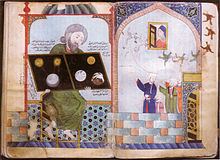Died 960 AD | ||
 | ||
Books Corpus Alchemicum Arabicum Vol. 1B (CALA1 B): Book of the Explanation of the Symbols People also search for Theodor Abt, Wilferd Madelung, Thomas Hofmeier, M. Turab Ali | ||
Ibn Umayl, Senior Zadith, Muhammed ibn Umail at-Tamîmî (Arabic: محمد بن أميل التميمي) was an alchemist of the tenth century. He can be dated to 900–960 AD (286-348 AH) on the basis of the names of acquaintances he mentioned. About his life, since he lived in seclusion, very little is known. Ibn Umayl may have been born in Spain of Arabic parents for a Vatican Library catalogue lists one manuscript with the nisba Andalusian but his writings suggest he mostly lived and worked in Egypt. He also visited North Africa and Iraq. Ibn Umayl has been considered a Gnostic Hermetist who seems to have led an introverted life style, which he recommended to others in his writings. Statements in his writings, comparing the Alchemical oven with Egyptian temples suggest that he might have lived for some time in Akhmim, the former centre of Alchemy. He also quoted alchemists that had lived in Egypt: Zosimos of Panopolis and Dhul-Nun al-Misri.
Contents
- Allegorical alchemist
- The interpreter
- Works Attributed to ibn Umail
- Later Publications
- Value to Scholars
- Value to Psychology
- References
In later European literature ibn Umayl became known by a number of names, including Senior from the title Sheikh becoming 'senior' by translation into Latin, Senior Zadith from the honorific al-sadik becoming Zadith phonetically and Zadith filius Hamuel, Zadith ben Hamuel or Zadith Hamuelis from an erroneous translation of ibn Umail.
Allegorical alchemist
Ibn Umayl was what is now called an allegorical alchemist. He saw himself as following his “predecessors among the sages of Islam” in rejecting alchemists who take their subject literally. Although such experimenters discovered the sciences of metallurgy and chemistry, Ibn Umayl felt the allegorical meaning of alchemy is the precious goal that is tragically overlooked. He wrote:
“Eggs are only used as an analogy... the philosophers … wrote many books on such things as eggs, hair, the biles, milk, semen, claws, salt, sulphur, iron, copper, silver, mercury, gold and all the various animals and plants … But then people would copy and circulate these books according to the apparent meaning of these things, and waste their possessions and ruin their souls” The Pure Pearl chap. 1.
For all his devotion to Greek alchemy Ibn Umayl wrote as a Muslim, frequently mentioning his religion, explaining his ideas "for all our brothers who are pious Muslims" and quoting verses from the Quran.
The interpreter
Ibn Umail presented himself as an interpreter of mysterious symbols. He set his treatise Silvery Water in an Egyptian temple Sidr wa-Abu Sîr, the Prison of Yasuf, where Joseph learned how to interpret the dreams of the Pharaoh. (Koran: 12 Yusuf and Genesis: 4)
"... none of those people who are famous for their wisdom could explain a word of what the philosophers said. In their books they only continue using the same terms that we find in the sages .... What is necessary, if I am a sage to whom secrets have been revealed, and if I have learned the symbolic meanings, is that I explain the mysteries of the sages."
The psychologist CG Jung recognized in ibn Umayl’s story the ability to bring self-realization to a soul by interpreting dreams, and from the 1940s onwards focused his work on alchemy. In continuation of Jung's approach towards alchemy, the psychologist Theodor Abt states that Ibn Umail's Book of the Silvery Water and the Starry Earth gives a description of a process of distillation, which is meant as image for a process of "continuous pondering over the different symbols", creating thus consciousness (symbolised by 'light', 'gold') out of the reality of matter, nature and body ('starry earth'). This shows that the "alchemical process is in fact entirely a psychological work that is based on dealing with concrete matter and the bodily reality."
Ibn Umails Book of the Explanation of Symbols (Ḥall ar-Rumūz) can be considered as a summary of his Silvery Water and Starry Earth, giving a "unified synthesis of Ibn Umail's earlier works".
Works Attributed to ibn Umail
Later Publications
Value to Scholars
The Silvery Water was particularly valuable to Stapleton, Lewis, and Sherwood Taylor, who showed that of some of Umail's Sayings of Hermes came from Greek originals. Also its numerous quotations from earlier alchemical authors allowed, for example, Stapleton to provenance the Turba Philosophorum as being Arabic in origin, and Plessner to date the Turba ca. 900AD.
For the history of alchemy, as Marie-Louise von Franz points out, Ibn Umail's Book of the Explanation of Symbols (Ḥall ar-Rumūz) can be regarded as a cultural link "within the mystical branch of alchemy, between the Gnostic Hermetic Greek alchemy and that of the mystical Latin alchemy in Europe", enabling a "better understanding of the religious dimension of symbolic Arabic alchemy". Among others, Ibn Umail commented on typical Pharaonic images and symbols such as the frog and snail, thus connecting the work of alchemy to the Egyptian quest for creating a resurrection body.
Value to Psychology
By using symbolical images, Ibn Umail described psychic phenomen, which makes his work of particular interest for modern psychology, especially of how to deal with desirousness and "how to contain the drivenness by the hellish-divine fire, that he calls the male soul, in its very opposite, the divine water that he calls the female spirit."
